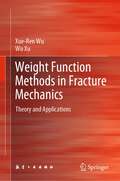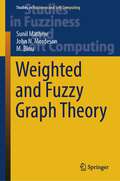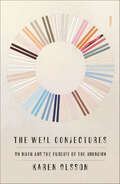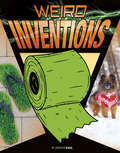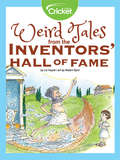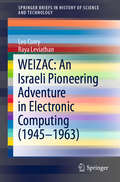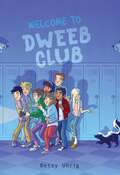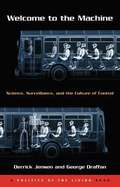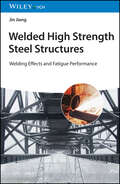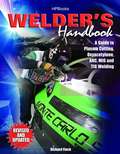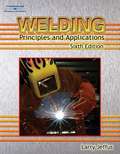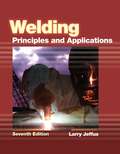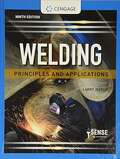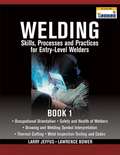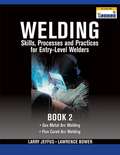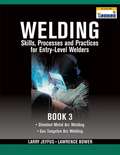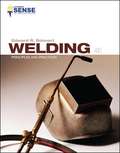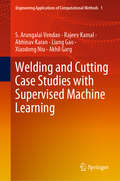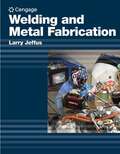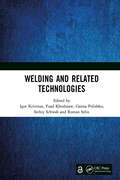- Table View
- List View
Weight Function Methods in Fracture Mechanics: Theory and Applications
by Xue-Ren Wu Wu XuThis book provides a systematic and standardized approach based on the authors’ over 30 years of research experience with weight function methods, as well as the relevant literature. Fracture mechanics has become an indispensable tool for the design and safe operation of damage-tolerant structures in many important technical areas. The stress intensity factor—the characterizing parameter of the crack tip field—is the foundation of fracture mechanics analysis. The weight function method is a powerful technique for determining stress intensity factors and crack opening displacements for complex load conditions, with remarkable computational efficiency and high accuracy.The book presents the theoretical background of the weight function methods, together with a wealth of analytical weight functions and stress intensity factors for two- and three-dimensional crack geometries; many of these have been incorporated into national, international standards and industrial codes of practice. The accuracy of the results is rigorously verified, and various sample applications are provided. Accordingly, the book offers an ideal reference source for graduate students, researchers, and engineers whose work involves fracture and fatigue of materials and structures, who need not only stress intensity factors themselves but also efficient and reliable tools for obtaining them.
Weighted and Fuzzy Graph Theory (Studies in Fuzziness and Soft Computing #429)
by Sunil Mathew John N. Mordeson M. BinuOne of the most preeminent ways of applying mathematics in real-world scenario modeling involves graph theory. A graph can be undirected or directed depending on whether the pairwise relationships among objects are symmetric or not. Nevertheless, in many real-world situations, representing a set of complex relational objects as directed or undirected is not su¢ cient. Weighted graphs o§er a framework that helps to over come certain conceptual limitations. We show using the concept of an isomorphism that weighted graphs have a natural connection to fuzzy graphs. As we show in the book, this allows results to be carried back and forth between weighted graphs and fuzzy graphs. This idea is in keeping with the important paper by Klement and Mesiar that shows that many families of fuzzy sets are lattice isomorphic to each other. We also outline the important work of Head and Weinberger that show how results from ordinary mathematics can be carried over to fuzzy mathematics. We focus on the concepts connectivity, degree sequences and saturation, and intervals and gates in weighted graphs.
The Weil Conjectures: On Math and the Pursuit of the Unknown
by Karen OlssonA New York Times Editors' Pick and Paris Review Staff Pick"A wonderful book." --Patti Smith"I was riveted. Olsson is evocative on curiosity as an appetite of the mind, on the pleasure of glutting oneself on knowledge." --Parul Sehgal, The New York TimesAn eloquent blend of memoir and biography exploring the Weil siblings, math, and creative inspirationKaren Olsson’s stirring and unusual third book, The Weil Conjectures, tells the story of the brilliant Weil siblings—Simone, a philosopher, mystic, and social activist, and André, an influential mathematician—while also recalling the years Olsson spent studying math. As she delves into the lives of these two singular French thinkers, she grapples with their intellectual obsessions and rekindles one of her own. For Olsson, as a math major in college and a writer now, it’s the odd detours that lead to discovery, to moments of insight. Thus The Weil Conjectures—an elegant blend of biography and memoir and a meditation on the creative life.Personal, revealing, and approachable, The Weil Conjectures eloquently explores math as it relates to intellectual history, and shows how sometimes the most inexplicable pursuits turn out to be the most rewarding.
Weird Inventions (Anything But Ordinary)
by Jennifer KaulHumans are ingenious when it comes to meeting challenges. We invent all sorts of useful contraptions from the wheel to the can opener. But some of the things people have come up with are truly odd. Who came up with grass sandals, and why? Have you ever heard of a portable radio hat? Not many people have, but someone invented it. Get the inside scoop on these odd contraptions and many more weird inventions.
Weird Tales from the Inventors' Hall of Fame
by Liz HuyckHave you ever wondered how war machines were created? Or the origin of beauty salons? Or maybe even how rubber is used in tires, and rubber shoes? Learn more about these renowned inventors and how their inventions helped shape modern life into the way we know it now!
WEIZAC: An Israeli Pioneering Adventure in Electronic Computing (SpringerBriefs in History of Science and Technology)
by Leo Corry Raya LeviathanThe book tells the unique story of WEIZAC, an early computer built by a “new nation” in the early 1950s. It was created in Israel, even though the feasibility of this project was actually close to null when it was initially conceived, in 1946, and, unlike most of the early computer projects, was privately financed mainly by the Jewish world community. The book draws on a wealth of documents and historical insights to reveal the processes and powers that led to the successful completion of the project and, as well as its actual impact on scientific activities in Israel, and on the rise of a local computing community.Based on archival data, the book shows how a synergy of personal dedication together with an organizational and national mission that links the Zionist vision with science and technology for the Jewish people helped to achieve a well-defined goal.The book offers intriguing insights and refreshing perspectives to all readers interested in the Zionist movement or in the history of computing.
Welcome, Humans: A Visit to the Robot Hotel (Fountas & Pinnell Classroom, Guided Reading Grade 4)
by Susanna LoboROBOTS EVERYWHERE At one hotel in Japan, guests are greeted at the front desk by robot workers—and robot dinosaurs! Actually, very few humans work here. At this hotel, almost all the workers are robots. NIMAC-sourced textbook
Welcome to Dweeb Club
by Betsy UhrigFor fans of Gordon Korman comes a hilarious, heartfelt middle grade adventure about a school club whose members stumble across video footage of themselves from five years in the future.What if a school club changed your life forever? In the second week of seventh grade, Jason Sloan signs up for the brand-new HAIR Club. He and his friends have no idea what it&’s about, but since they&’re the first to sign up they figure they&’ll be in charge in no time. The club turns out to be super weird: using fancy new equipment donated by a mysterious benefactor, the members are supposed to monitor school security footage. Their first assignment: find out what is stealing the cafeteria&’s croutons. Instead of the expected dark cafeteria, the computers show the club members something else entirely: actual footage of themselves as high school seniors, five years in the future! What on earth could be happening? Is it some kind of time warp, or alternate reality? Or is it just an un-funny prank? As they scramble to solve the mystery, they can&’t help but notice something else—none of them like what they see five years from now. Is there any way to change the future—and their fates? Figuring out who you are and who you want to become has never been funnier in this laugh-out-loud romp through the perils of middle school—and beyond.
Welcome to the Machine
by Derrick Jensen George DraffanYou could call them the Monkeywrench Gang of the nanotech age. Derrick Jensen and George Draffan are taking down the data mining industry, one converted mind at a time. In the face of RFID chips, consumer tracking strategies, and illegal government wiretapping, Jensen and Draffan are determined to show consumers how to fight back against government and industry to regain their rights, their privacy, and their humanity. In "Welcome to the Machine: Science, Surveillance, and the Culture of Control," Jensen and Draffan take a hart-hitting look at the way technology is used as a machine, to control us and our environment. Most people would be disturbed if you told them that everything from their store purchases to their public transit rides are recorded and filed for government or corporate access. But more often than not, the smooth, silent cleanliness of its operation allows the Machine of Western Civilization to go unnoticed. Jensen and Draffan are back to reveal both the terrifying extent of surveillance today and our chilling complacency at the loss of everything from consumer privacy to civil liberties. In this timely and important new collaboration, Jensen and Draffan take on all aspects of Control Culture: everything from the government's policy of total information awareness to a disturbing new technology where soldiers can be given medication to prevent them from feeling fear. They write about pharmaceutical packaging that reports consumer information, which is then used to send targeted drug advertisements directly to your TV.
Welded High Strength Steel Structures: Welding Effects and Fatigue Performance
by Jin JiangWelded High Strength Steel Structures Understand the impact of fatigue on high strength steel joints with this comprehensive overview High strength steels are highly sought after for industrial and engineering applications ranging from armored vehicles to welded engineering components built to withstand considerable stress. The mechanical properties of welded joints made from high strength steel are integrally linked to the specific welding process, which can have an enormous impact on fatigue performance. Welded High Strength Steel Structures: Welding Effects and Fatigue Performance provides a comprehensive analysis of high strength steel joints and the ramifications of the welding process. It guides readers through the process of performing thermal analysis of high strength steel structures and evaluate fatigue performance in the face of residual stress. The result is a volume with innumerable use cases in engineering and manufacture. Welded High Strength Steel Structures readers will also find: An author with decades of experience in research and engineering Numerous studies of various classes of high strength steel joints Studies on tubular structures for welding residual stress Welded High Strength Steel Structures is a must-own for welding specialists, materials scientists, mechanical engineers, and researchers or industry professionals in related fields.
Welder's Handbook: A Guide to Plasma Cutting, Oxyacetylene, Arc, MIG and TIG Welding
by Richard FinchThe author talks about the evolution of welding along with technology, mentioning how arc welding equipment which once used to be the size of a refrigerator is now available as a compact pluggable gadget.
Welding (Fundamentals of Service Series)
by Deere Company StaffThe main purpose of this manual is to explain the different types of welding processes, cutting, brazing, soldering, surfacing, design of welds, properties of metals and welding safety. For the novice, this manual is a training guide. All-new welding projects at the end of the book augment this training. For the journeyman, it is a reference. This manual can be used by anyone -- experienced mechanics and shop trainees; as well a vocational students and interested laymen. It starts with the basics and builds your knowledge step-by-step in a very structured manner, making the information easy to understand.
Welding: Principles and Applications
by Larry JeffusThis newly updated sixth edition of Welding: Principles and Applications features tight shots of actual welds to speed beginners to an understanding of a variety of different welding processes used today. Moving quickly from basic concepts to the study of today's most complex welding technologies, each section begins by introducing readers to the materials, equipment, setup procedures, and critical safety information they need to know to successfully execute a specific process. Remaining chapters in the section zero in on individual welding tasks and must-know techniques. Comprehensive coverage spans from specific welding processes to discussion of related topics, including welding metallurgy, metal fabrication, weld testing and inspection, joint design, and job costing. Objectives, key terms, review questions, lab experiments, and practice exercises in every chapter are also included to focus attention on information and skills required for success as a professional welder.
Welding: Principles and Applications
by Larry Jeffus<p>This proven guide provides students with the knowledge and skills they need to complete AWS SENSE Level I and Level II programs, create Workmanship Qualification Specimens, and earn professional certification. Advancing rapidly from basic concepts and processes to today’s most complex, cutting-edge welding technologies and practices, this comprehensive text features valuable information on topics such as welding metallurgy, metal fabrication, weld testing and inspection, joint design, job costing, and environmental and conservation tips. <p>The author opens each section by introducing students to the materials, equipment, setup procedures, and critical safety information they need to execute a specific process successfully, while subsequent chapters focus on individual welding tasks leading to SENSE certification.</p>
Welding: Principles and Applications
by Larry JeffusNow nearing its 30th year of publication, WELDING: PRINCIPLES & APPLICATIONS (WP&A), 7th Edition is the authoritative introduction to the subject of welding. It's designed for students in a wide range of academic and workforce training programs who want to pursue careers as skilled welders and welding supervisors. The text also supports the needs of learners who need to achieve a basic level of proficiency in welding in their chosen skilled trade. While covering the procedural and safety information all students need, WELDING: PRINCIPLES & APPLICATIONS also explains underlying theories. The combination of hands-on information with clear explanations of theory is a hallmark of this book. The depth of coverage allows it to be used as the core text in a multi-course welding curriculum, generally starting with shielded metal arc welding, and then covering other basic processes and more advanced techniques.
Welding: Principles and Applications
by Larry JeffusThis proven guide provides the knowledge and skills you need to complete AWS SENSE Level I and Level II programs, create Workmanship Qualification Specimens, and earn professional certification. Advancing rapidly from basic concepts and processes to today s most complex, cutting-edge welding technologies and practices, this comprehensive text features valuable information on topics such as welding metallurgy, metal fabrication, weld testing and inspection, joint design, job costing, and environmental and conservation tips. <p><p>The author opens each section by introducing you to the materials, equipment, setup procedures, and critical safety information you need to execute a specific process successfully, while subsequent chapters focus on individual welding tasks leading to SENSE certification. <p><p>In addition to hundreds of new photos showcasing current welding tools and techniques, the Ninth Edition includes new and updated information on GTAW cup walking, induction welding machine operations, innovations in PAC equipment, and other industry advances you are likely to encounter as you begin your career as a welding professional.
Welding: Principles and Applications (6th edition)
by Larry JeffusThis newly updated sixth edition of Welding: Principles and Applications features tight shots of actual welds to speed beginners to an understanding of a variety of different welding processes used today. Moving quickly from basic concepts to the study of today's most complex welding technologies, each section begins by introducing readers to the materials, equipment, setup procedures, and critical safety information they need to know to successfully execute a specific process. Remaining chapters in the section zero in on individual welding tasks and must-know techniques. Comprehensive coverage spans from specific welding processes to discussion of related topics, including welding metallurgy, metal fabrication, weld testing and inspection, joint design, and job costing. Objectives, key terms, review questions, lab experiments, and practice exercises in every chapter are also included to focus attention on information and skills required for success as a professional welder.
Welding: Book One
by Larry Jeffus Lawrence BowerWelding: Skills, Processes, and Practices for Entry-Level Welders is an exciting new series that has been designed specifically to support the American Welding Society’s (AWS) SENSE EG2. 0 training guidelines. Offered in three volumes, these books are carefully crafted learning tools consisting of theory-based texts that are accompanied by companion lab manuals, and extensive instructor support materials. With a logical organization that closely follows the modular structure of the AWS guidelines, the series will guide readers through the process of acquiring and practicing welding knowledge and skills. For schools already in the SENSE program, or for those planning to join, Welding: Skills, Processes, and Practices for Entry-Level Welders offers a turnkey solution of high quality teaching and learning aids.
Welding: Book 2
by Larry Jeffus Lawrence BowerWelding: Skills, Processes, and Practices for Entry-Level Welders is an exciting new series that has been designed specifically to support the American Welding Society’s (AWS) SENSE EG2. 0 training guidelines. Offered in three volumes, these books are carefully crafted learning tools consisting of theory-based texts that are accompanied by companion lab manuals, and extensive instructor support materials. With a logical organization that closely follows the modular structure of the AWS guidelines, the series will guide readers through the process of acquiring and practicing welding knowledge and skills. For schools already in the SENSE program, or for those planning to join, Welding: Skills, Processes, and Practices for Entry-Level Welders offers a turnkey solution of high quality teaching and learning aids.
Welding: Book 3
by Larry Jeffus Lawrence BowerWelding: Skills, Processes, and Practices for Entry-Level Welders is an exciting new series that has been designed specifically to support the American Welding Society’s (AWS) SENSE EG2. 0 training guidelines. Offered in three volumes, these books are carefully crafted learning tools consisting of theory-based texts that are accompanied by companion lab manuals, and extensive instructor support materials. With a logical organization that closely follows the modular structure of the AWS guidelines, the series will guide readers through the process of acquiring and practicing welding knowledge and skills. For schools already in the SENSE program, or for those planning to join, Welding: Skills, Processes, and Practices for Entry-Level Welders offers a turnkey solution of high quality teaching and learning aids.
Welding: Principles and Practices
by Raymond J. Sacks Edward R. BohnartThis text introduces students to a solid background in the basic principles and practices of welding. It first introduces fundamental theory of the welding process (gas arc, semi-automatic, automatic, and robotic welding) and then provides practice jobs so students develop manipulative skills and technical understanding. Metals and their welding characteristics, safety practices, welding symbols, and the fundamentals of print reading are all covered.
Welding and Cutting Case Studies with Supervised Machine Learning (Engineering Applications of Computational Methods #1)
by S. Arungalai Vendan Rajeev Kamal Abhinav Karan Liang Gao Xiaodong Niu Akhil GargThis book presents machine learning as a set of pre-requisites, co-requisites, and post-requisites, focusing on mathematical concepts and engineering applications in advanced welding and cutting processes. It describes a number of advanced welding and cutting processes and then assesses the parametrical interdependencies of two entities, namely the data analysis and data visualization techniques, which form the core of machine learning. Subsequently, it discusses supervised learning, highlighting Python libraries such as NumPy, Pandas and Scikit Learn programming. It also includes case studies that employ machine learning for manufacturing processes in the engineering domain. The book not only provides beginners with an introduction to machine learning for applied sciences, enabling them to address global competitiveness and work on real-time technical challenges, it is also a valuable resource for scholars with domain knowledge.
Welding and Metal Fabrication
by Larry JeffusWELDING AND METAL FABRICATION employs a unique hands-on, project-based learning strategy to teach welding skills effectively and keep you motivated. This groundbreaking new book connects each welding technique to a useful and creative take-home project, making exercises both practical and personal―and avoiding the tedium of traditional, repetitive welding practices. To further enhance the learning process, every welding project includes a set of prints with specifications, like those used in production fabrication shops. This full-featured approach to skill-building reflects the reality of professional welding, where following prints and instructions precisely and laying out, cutting out, and assembling weldment accurately are just as essential as high-quality welding. The included projects are small to conserve materials during the learning process, but detailed instructions and abundant photos and illustrations guide you through a wide range of fabrication skills. Key steps and techniques within the small projects are also linked to larger projects presented at the end of each chapter, enabling you to apply what you have learned by fabricating and welding something more substantial. This thorough, reader-friendly book also prepares you for real-world success by covering shop math and measurement, time and material tracking, and invoicing.
Welding and Related Technologies: Proceedings of the VIIth International Conference on Welding and Related Technologies (WRT 2024, 7-10 October 2024, Yaremche, Ukraine)
by Igor KrivtsunWelding and Related Technologies contains the papers presented at the VIIth International Conference on “Welding and Related Technologies” (WRT 2024, Yaremche, Ukraine, 7-10 October 2024). The topics covered include: Innovative Technologies, Materials and Equipment for Welding and Related Processes Strength and Stress-Strain States of Welded Joints and Structures Additive Technologies New Structural And Functional Materials, Nanomaterials, Composites Surface Engineering Mathematical Modeling of Welding And Related Processes Advanced Technologies of Special Electrometallurgy Non-Destructive Testing and Technical Diagnostics Materials and Technologies for Medicine and Ecology of Welding Production Welding and Related Technologies is of interest to scientists from academic institutions, universities and industry, domain experts, and postdoctoral fellows interested in the latest theoretical developments and applications of welding.
Welding Engineering
by David H. PhillipsProvides an introduction to all of the important topics in welding engineering. It covers a broad range of subjects and presents each topic in a relatively simple, easy to understand manner, with emphasis on the fundamental engineering principles.* Comprehensive coverage of all welding engineering topics * Presented in a simple, easy to understand format * Emphasises concepts and fundamental principles
